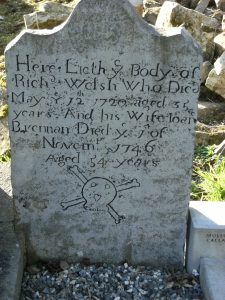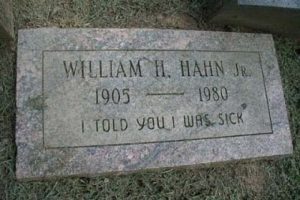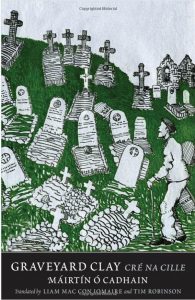I was once told by an American psychotherapist that the Irish have serious problems with bereavement. Apparently we find it very hard to let go. Maybe that’s the reason we have such a thing about graveyards. Because we certainly do have a thing about graveyards.
Last week I checked the site historicgraves.com and discovered the number of places covered had more than quadrupled in three years. It took two whole days just to add them into the listings (check out Limerick just to get a sense of the scale).

Historicgraves depends on volunteer community projects and often records much more than the inscriptions, going into the detail of the heritage of each graveyard. It currently has transcripts for 484 cemeteries, mostly in Cork, Limerick and Tipperary, though there are also significant numbers elsewhere.
There are also two other Irish groups wholly dedicated to transcription and free publication of inscriptions, www.discovereverafter.com and www.irishgraveyards.ie. Both are private companies supplying cemetery management services, with online transcript collections as a kind of by-product. Discovereverafter is based in Derry, with most of its transcripts from counties Derry, Tyrone and Armagh (118 graveyards currently). Irishgraveyards is based in Castlebar, and covers mainly Mayo, Galway and Donegal (74 graveyards).
All three adhere to the current gold standard: transcript, headstone photo and map. Despite their current regional focus, all three also appear to have country-wide ambitions.
This is not to mention the transcriptions being carried out by heritage groups supported by local authorities or libraries: in Galway, West Cork, Kildare and Meath, Clare, Wexford … Where have I missed?
And then there’s the IGP archives, volunteer-supported and growing rapidly – their transcripts for Mount Jerome in Dublin (to mention just one) are superb. Not to forget Dr. Jane Lyons’ massive collection of more than 70,000 records on her site from-ireland.net .

Many non-Irish sites have also picked up the bug. There are plenty of Irish transcripts on the venerable interment.net and findagrave.com, and many Irish headstone photos on gravestonephotos.com.
The work of previous generations of transcribers hasn’t gone away either. For Northern Ireland by the Ulster Historical Foundation has a huge transcript-only collection for Ulster at ancestryireland.com. Other IFHF members are putting their collections on rootsireland.ie, with Derry, East Galway, South Mayo, North Tipperary and Westmeath leading the pack.
And of course more than a century’s-worth of published transcripts are also out there.
- The Journal of the Association for the Preservation of the Memorials of the Dead ran from 1888 to 1934, recording tens of thousands of inscriptions, many now gone – the journals up to 1909 are now online at archive.org.
- Brian Cantwell’s life’s work, Memorials of the Dead, comprising c. 24,500 inscriptions, covering all of Wicklow, Wexford and part of Dublin, is widely available in major libraries and is online at FindMyPast. Seaboard Mayo and Galway sites were transcribed by his son Ian, whose site www.iancantwell.com includes indexes, as well as an interesting history of memorial transcripton and methodological analysis.
- Albert Casey’s gargantuan 17-volume O’Kief, Cosh Mang, Slieve Lougher, and Upper Blackwater in Ireland covers 42 graveyards in Cork and 36 in Kerry.
I could go on …
One of the strange upshots is that more and more cemeteries have multiple transcripts. Current leaders (as far as I know) St. James’ (Mervue) in Galway and Agher in Meath, each transcribed no fewer than four separate times.
 Mairtín Ó Cadhain’s Irish-language masterpiece Cré na Cille takes place in a graveyard, with the dead giving out to each other, making scurrilous jokes and complaining about the living. I suspect a sequel might have them pleading with transcribers to leave them alone for a while.
Mairtín Ó Cadhain’s Irish-language masterpiece Cré na Cille takes place in a graveyard, with the dead giving out to each other, making scurrilous jokes and complaining about the living. I suspect a sequel might have them pleading with transcribers to leave them alone for a while.
Loved it.
When I was young (and pre-verbal) my mother (Kerry) walked me on weekdays around our neighborhood in my baby carriage (pram). One day my father (Leitrim) had a holiday from work and volunteered to do the job.
When we returned from our jaunt, I am told, he handed me back to my mother and sputtered “The cemetery ! I was pushing her past it and she pointed at it and started fussing to the point that I had to take her in there. What the h**l did she want to go in there for?”
My mother calmly replied, “Because we go there every day on our walk.”
Hi
My name is Mike O’Meara and I am a volunteer researcher at Daltons house which is in Tipperary Town. I Just came across your site and would like to inform you that at Daltons we have a database of over 200 graveyards which are not in the public domain.
They were compiled in the mid 1990s by students on a FAS summer scheme and the date from the mid 1700s to early 1900s I would appreciate any guidance/ information on making them available to the public.
The link is to our Facebook page which lists the graveyards.
If you would like further information please get in touch.
Regards
Mike O’Meara
https://www.facebook.com/Daltons-Heritage-And-Visitor-centre-tipperary-1671708563045040/?ref=page_internal
Very comprehensive sites. Some are on My Heritage, some are not. I will need to research some in the Armagh area.
Have often wished for a comprehensive listing of what is out there, although I do appreciate that it is a constantly changing set of data. Some of the sites listed are terrific, others are challenging to search and very limited in areas covered. How I wish that those who record these wonderful sites could somehow collaborate. What for example is the point in a voluntary group spending weeks and weeks photographing and recording a graveyard that has already been recorded by another group?
I have been asked to do my local cemeteries, but they are already online, so the objective is lost on me!
It think it is understood that gravestones do deteriorate over time, so what is legible today may not be legible in a decade or so. It would be wonderful if County Councils and or churches could take over the online recording of new burials and maintenance of databases of all legible headstones in their care. Wishful thinking or am I totally delusional!
“Brian Cantwell’s life’s work, Memorials of the Dead, comprising more than 23,000 inscriptions, covering all of Wicklow and Wexford and many Mayo and Galway cemeteries” should read “Brian Cantwell’s life’s work, Memorials of the Dead, comprising c. 24,500 inscriptions, covering all of Wicklow, Wexford and part of Dublin; seaboard Mayo and Galway sites were transcribed by Ian Cantwell” Indexes and analyses are on http://www.iancantwell.com. They reflect the evolution of rescue history to the ‘current gold standard’ as both transcribers focused on transcriptions alone due to the many restraints of county-wide solo research.
Ian, the work of your father does not reflect anything. He was an incredible man who took on a work that no-one else in the country was taking on.. His work is irreplaceable.
The reason I took up graveyard work was because of reading the work done by him and one other.
I continue to be surprised how many resources are available for Irish genealogy! Thanks for making them known to us.
There’s also a comprehensive CD, ‘Graveyards of Laois’, by Jack McDonald. He mentioned to me some years ago he was going to work on Tipperary, Kilkenny and Carlow as well, but I don’t see anything about that online. No doubt they are mostly or all duplicates from more accessible sources, including Jane Lyons’ good coverage of Laois. Some of his transcriptions are also at IGP. The CD was once available through a website that’s now apparently defunct: http://www.genealogylaois.com/graveyards-of-laois-cd-page.html. Googling Jack McDonald finds him at various genealogy sites including here, where it gives the old address for obtaining the CD: info@genealogylaois.com
I bought “The Dirty Dust” yesterday at the Irish Arts Center in Manhattan 🙂 and met the translator Alan Titley. Maybe one day I can attempt to read “Cré na Cille” in Irish.
Thanks for all your work!
Do any of the sites cover graves in Cavan?
IGP has some for Cavan
http://www.igp-web.com/IGPArchives/ire/cavan/photos/tombstones/markers.htm
Plus I have about 24 Cemeteries that are not on IGP and there should be a few in the IGP queue
Hi Dave,
The cemetery I’m after is Drumgoon but IGP only has 2 gravestones for there. I’ve been there but it’s all overgrown and the land is sunken. If you have any info for there for Kindelan/Kinlan etc 1800 – 1850 I’d be very grateful.
Thanks,
Kat
John,
Thank you for mentioning from-ireland.net
You mention the main counties covered by the company historic graves but even though you list from-ireland and give a number of names I have in my index, you don’t mention the counties I cover. Mainly Laois and Kilkenny. I have #60 Laois graveyards and 40 Kilkenny ones, then I have others going from Glengarrif in Cork up to Deansgranges in Dublin.
All the other Irish groups you mention are professional companies. Numbers of people working for them or volunteer groups working with them. My work was all varried out by me, one individual with no body paying for anything. My work was my time, my effort and my costs. This may be considered irrelevant to others but I was not seeking my family, I did this for the love of it. I put my web site online, I pay all the money for the costs. I am NOT a professional company, I am one woman working on her own and I have over 100 graveyards for Laois and Kilkenny on line and I don’t know how many others for how many other counties also.
Thank you for mentioning from-ireland once again.
Kerry Co. Co have the books for burials online. Oughterard Heritage have done extensive work on Kilcummin graveyard. For old graveyards, would the parish not have some records regarding burials?
Very few Catholic parishes have 19th-centuiry burial registers
Kerry Co. Co have the books for burials online. Oughterard Heritage have done extensive work on Kilcummin graveyard. For old graveyards, would the parish not have some records regarding burials?
Not all the other Irish groups mentioned are professional companies, all my work was all carried out by me too, one individual with no body paying for anything either.
Similarly work was my time, my effort and my costs with over 5o Cemeteries for Co Leitrim alone on IGP, ( http://www.igp-web.com/IGPArchives/ire/leitrim/photos/tombstones/markers.htm ),
20+ for Longford, 20+for Cavan, 20+ Monaghan, 20+ Sligo, 10+ Roscommon plus some Donegal, Tyrone, Armagh, Westmeath, Galway, Mayo and a pile more in the pipeline.
I did this for the love of it too, don’t have an Accountant and have spent a small fortune on batteries.. :-))
Thank you. I’m looking for information about Longford ancestors. This could be of help.
There are some amazing graveyard inscription books for Connemara, Co Galway — a project that was done about 10 years back as a work scheme for the local Gaeltacht community. They were sold at Post Offices locally, and are now out of print. Copies might be at Galway Library or NUI Galway Library. I have several of them, and consult them regularly for Lettermore na’ Coille, Lettermore, and Spiddal cemeteries.
They were transcribed locally, with photographs of many family members, and an index in the back with “local” names (i.e. Martin Joe Seamus, etc) and other family members interred in the same grave, but not listed on headstone.
They are a fabulous resource…..
Great article. My first boss had a fascination with graveyards and my early working days driving around the Midlands involved visiting lots of them. I’d get a bit of a history lesson if he was familiar with certain names. I certainly appreciate those visits now. Thanks John.
One of my favourite resources when I was researching some old Co Kildare links recently was this one:
http://kildare.co/Kildare-Graveyards-by-Parish.asp
The highly accurate maps are only brilliant …
I was able to locate Gladhealy, a tiny one in the middle of nowhere … well done Kildare county council ?
Even with all the Irish sources available, I have (in 55years) never been able to trace my G Grandfather’s wife’s (Laura Jane Mahoney) family in Ireland: Her father, John R. Mahoney born Nov 1837 in Ireland, West Munster, Kerry County, died 1932 Danville Vermillion Illinois USA. **Married Elizabeth Ann Reno born 1839 in Ohio, died 1913 in Iroquois County, Illinois USA. **Daughter Laura (Lauretta) Jane Mahoney born 1860 Ohio -died 1932 Illinois, married (my G Grandfather) George Howard Pierce 1856-1922. **The name Mahoney is so numerous, it is impossible for me to find anything substantial about him or his family in Ireland, nor have I found any passenger lists at Ellis Island that showed his arrival here or where he sailed from. **Laura had a sister Maggie 1872 and a brother James 1876. I post about John Mahoney every chance I have, hoping that, someday, someone might have information I could use. He was a Catholic but I have no information about what church he might have belonged to in West Munster, a location I have concentrated on since finding that West Munster was an area where the name Mahoney was very prevalent. Is there any hope for me to find anything?
Are there any Waterford graveyards recorded and where to find them
Have a look here.
Any graves around Glencolumbkille, Co. Donegal, Ire!and?
Nice post. Irish graveyards are challenging. As one comment noted, 19th century registers are spotty. One of my ancestors died in 1847. His death is mentioned in the parish register. Yet, no grave marker survives for him. If he was mentioned in the Cappatagle RC parish records, then can I assume he was likely buried in the Capptagle RC parish cemetery? I could not find a marker for his grave, even though other family markers survive from the same time period.
In the IFHF burial records there are people dying in both Castlecomer and Slieverue parish but buried in Mallardstown parish, while there being no other record available of their burials in Mallardstown. These burial records stretch from 1780 to 1834 to several examples circa 1900. Seems awfully suspicious. Have you heard that students originally transcribed the IFHF records in the ’90s under a government program? If so, I’m wondering how much oversight they had. These examples would suggest not much. Here’s a few (https://www.irelandxo.com/ireland/kilkenny/mallardstown/message-board/mallardstown), and two others were noted in a Facebook group. I have a feeling there were more people supposedly buried in Mallardstown.